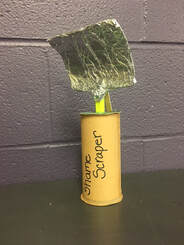|
By Deborah McNemee  The Shame Scraper! The Shame Scraper! Last week, Michaela Liebst shared with us an inspired idea that brought together what we think of as traditional academic skills with creativity. Her blog post comes just at the right time when most students and educators are feeling quite bogged down with our technology-heavy new normal. Liebst offers a great reminder that innovation in the classroom doesn’t always need to be tech-based. Her blog reminds me of an assessment I’ve used with my honors and AP students. The adjectives that normally accompany honors and AP assessments might include grueling, taxing, and rigorous. Did you know that if you look up rigorous in the 10th edition of the Webster’s Collegiate dictionary, you’ll find the synonyms harsh and severe? Scrupulously accurate is also found. That sounds better, but taxing and grueling give you wearing and punishing. Except for the accurate part of those definitions, none of those words are ones I’d prefer to be associated with the academic curiosity and excellence necessary for honors or AP learning. For any learning, come to think of it. While thorough and challenging exams are naturally part of accelerated classes, there is still room for innovation and--dare I say it--fun. One year, after my honors had quizzed and essayed their way through Hawthorne’s The Scarlet Letter and Miller’s The Crucible, I decided to offer a different kind of assessment. that would not only test their ability to follow written instructions (which is sometimes surprisingly lacking) and innovate on demand, but it would also allow me to assess several other elements. First, I divided the class into small groups of 3 to 4 students. Next, I handed out the instructions. Students were to create an advertisement for a product that a specific character from either story would need or use. In the advertisement, the students must apply their understanding of the character, plot, conflicts, satire, and appeals. They must include a script that demonstrates knowledge and application of writing skills, including punctuation and grammar usage. Oh, and one more thing, they also had to create the product. They could use anything in the classroom or in their backpacks. Then each group drew a character’s name from a hat. They had about one hour to complete the task. At the end of the hour the groups presented their product and their commercial. While the reading and vocab quizzes and essays were a necessary part of my lessons, none of those assessments could come close to checking so many elements all at once. With this one assignment I was able to assess the following items:
Of course, this was simply a theory until I put it to practice. Mind you, these student guinea pigs were used to rigorous exams. I wasn’t sure how they would take to this new model. At first, the students didn’t know what to make of it. After only a few minutes, however, they were digging through their backpacks, and rifling through their brains, and scavenging through the hoard of craft supplies and odd trinkets I’d provided. I had collected quite a collection of wrapping paper tubes, tin foil, play dough, popsicle sticks, pipe cleaners, googly eyes, and whatever else you can find at the Dollar Store or a garage sale.  My Little Daddy! My Little Daddy! The ultimate products were impressive. Hester Prynne’s Shame Scraper was a favorite. If she’d only had a way to scrape away her shame sooner, she would have saved herself and her child at least one hundred pages worth of anxious overthinking and self reproof. Rev. Dimmesdale Jackbone (a jacket with a backbone) could also have saved the day, along with his soul. Pearl’s My Little Daddy would have eliminated not only Hester’s soul-sucking dependence on the possibility that Dimmesdale might stop being a deadbeat dad, but also her own continuous creepy questioning about her father. Elizabeth Proctor needed an anti-witch spell kit to dispel Abigail Williams from Salem (bonus points for irony). Reverend Hale needed the New and Improved Edition of Incubus and Succubus for Dummies to carry in with his “heavy books... weighted with authority”. The commercials were as wonderful as the products. The activity was a hit. It also ended up being a successful assessment of many of the standards we’d studied in the last several weeks. The on-demand thinking required with this activity is key. The students did not know what we were doing ahead of time. Therefore, they could not bring in craft supplies that might benefit their preconceived ideas. The fact that they were required to use only what they could find in the classroom guided their thinking. The shapes, colors, utility, and amount of various supplies meant they had to truly problem solve together. They had never done something like this on-the-fly before, so no one was an expert. Each student had to put ideas on the table. Each student had to engage. Every team member had to move forward with a sense of faith and accountability. It was truly one of the most memorable moments of the year. Guess what else, many students claimed they understood the use of appeals and satire more so after that activity than they did after analyzing traditional texts. So, not only was it an assessment, it was also a good teaching tool. Another bonus--it was not another project that they had to take home and complete at midnight the night before it was due. It was a one and done class activity. No homework necessary. Also, no perfection required. For many students, homework breaks and perfection passes are very real blessings. While fun activities like this one should not completely replace traditional forms of testing, I do feel like they should absolutely act as supplements, or an enrichment at the very least. By the way, if you are nervous to try something so unconventional, let me know. I’ve got a gently used Jackbone that might help. It’s worth a try, anyway. We’d love for you to share your fun and creative classroom assignments. Share in the comments below or share on Twitter or Instagram with the hashtag #KATEclassroom. Don’t forget to tag @kansasenglish on Twitter and @kanasenglishblog on Instagram.  About the Author Deborah McNemee teaches at Andover Central High School where a culture of reading is alive and well. She creates a culture of reading with her students by annually hosting a project based event in partnership with Big Read Wichita. She facilitates a writing culture through encouraging involvement with the NaNowriMo Young Writers Program and submitting student work to Voices of Kansas. Her favorite books to read outside of school are classics. Check out her blog about keeping classics relevant for kids at www.KeepingClassics.com. Comments are closed.
|
Message from the EditorWelcome! We're glad you are here! Archives
April 2024
Categories
All
|
 RSS Feed
RSS Feed